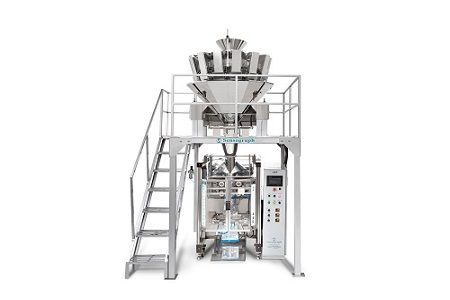Pouch packing machines are specialized equipment designed to package products into flexible pouches. These machines automate the process of filling, sealing, and labeling, making them a central part of the food packaging industry, pharmaceutical sector, and consumer goods manufacturing.
The rise of flexible packaging has made pouch machines widely used because they handle powders, liquids, granules, and solids efficiently. From snack foods to detergents, their adaptability supports multiple industries that require consistent packaging standards.

Importance: Why pouch packing matters today
The demand for efficient and safe packaging has grown as global supply chains expand and consumer preferences shift toward ready-to-use and portable products. Pouch packing machines help manufacturers:
-
Maintain product hygiene by reducing manual handling.
-
Increase efficiency through automated filling and sealing.
-
Support sustainability with eco-friendly pouch materials.
-
Extend product shelf life by ensuring airtight sealing.
Industries affected include:
-
Food and beverages – snacks, dairy, sauces, frozen goods.
-
Pharmaceuticals – tablets, powders, liquid medicines.
-
Agriculture – seeds, fertilizers, animal feed.
-
Chemicals and cosmetics – detergents, lotions, gels.
The problems these machines solve are rooted in consistency and scale. Manual packaging cannot keep up with modern demand, while automation enables accuracy in weight, speed, and quality.
Recent updates and trends in pouch packing (2024–2025)
The pouch packing sector has seen significant changes in the past year.
-
2024 – Rise of smart packaging technology: Many manufacturers adopted IoT-enabled packing machines that track production data in real time. This shift helps optimize resources and reduce wastage.
-
2024 – Sustainability focus: Companies increasingly use recyclable and biodegradable pouch films to meet consumer and regulatory expectations.
-
2025 – AI-driven automation: Early 2025 reports highlight the integration of machine learning algorithms in industrial automation, allowing predictive maintenance and reduced downtime.
-
Flexible packaging industry growth: According to packaging industry insights, flexible pouch packaging continues to grow due to convenience and reduced transportation weight.
Laws and policies impacting pouch packing
Packaging is governed by a mix of safety, labeling, and environmental regulations depending on the country. Common rules include:
-
Food safety standards: In many regions, pouch packing for edible products must comply with hygiene standards like the Food Safety and Standards Authority of India (FSSAI), FDA (US), or European Food Safety Authority (EFSA).
-
Environmental policies: Countries such as India and members of the EU have introduced regulations limiting single-use plastics, encouraging industries to adopt eco-friendly packaging materials.
-
Labeling requirements: Packaged products often must include nutritional data, batch numbers, and expiry dates, which pouch packing machines support through integrated printers.
-
Workplace safety norms: Use of heavy industrial automation machinery is regulated by occupational safety standards to protect operators.
Tools and resources for pouch packing machines
Businesses and professionals exploring pouch packing solutions can access a variety of resources:
-
Packaging software: Tools that calculate pouch dimensions, weight distribution, and sealing strength.
-
Automation platforms: Systems that integrate pouch machines with conveyor belts, sensors, and robotic arms.
-
Websites & databases:
-
Packaging World (industry trends and updates)
-
Flexible Packaging Association (reports and sustainability practices)
-
Food Processing Technology (machinery reviews and case studies)
-
-
Educational resources: Engineering forums, training guides, and packaging machinery manuals that explain setup and troubleshooting.
-
Process calculators: Online calculators for estimating pouch film thickness, sealing temperature, and fill volume.
How pouch packing machines work and setup process
Basic working mechanism
-
Film feeding – Roll stock or pre-made pouches are fed into the machine.
-
Pouch formation (if roll stock) – The film is shaped into a pouch using forming collars.
-
Filling system – The product is dispensed into the pouch using auger fillers, liquid pumps, or weighers depending on the material.
-
Sealing process – Heat or ultrasonic sealing closes the pouch, ensuring it is airtight.
-
Cutting and labeling – Individual pouches are cut and printed with batch details.
Setup process overview
Setting up a pouch packing machine involves:
-
Space planning: Ensuring proper layout for raw material storage, machine installation, and finished goods.
-
Utility connections: Machines often need stable electricity, compressed air, and sometimes vacuum lines.
-
Calibration: Adjusting weight fillers, sealing temperature, and speed settings.
-
Operator training: Personnel should be trained in machine operation, cleaning, and troubleshooting.
-
Trial runs: Test runs with sample products to ensure accuracy and seal integrity before full production.
Benefits of pouch packing machines
-
Speed and efficiency: Continuous operation reduces packaging time.
-
Accuracy: Automated weighing ensures product consistency.
-
Versatility: Handles powders, liquids, solids, and granules.
-
Shelf life extension: Airtight sealing prevents contamination.
-
Branding support: Machines enable custom printing and labeling.
-
Reduced wastage: Optimized sealing prevents product loss.
FAQs about pouch packing machines
What types of pouch packing machines exist?
There are several types, including vertical form-fill-seal (VFFS), horizontal form-fill-seal (HFFS), and pre-made pouch fillers. Each is suited to different industries and product types.
Are pouch packing machines suitable for small businesses?
Yes, smaller semi-automatic models are available for low production volumes, while large-scale industries use fully automated systems.
How do pouch machines support sustainability?
Modern machines are compatible with recyclable films, biodegradable materials, and optimized sealing methods that reduce material waste.
What maintenance is required?
Routine cleaning, lubrication of moving parts, checking sensors, and recalibrating sealing units are common maintenance tasks.
Which industries benefit the most?
Food, beverages, pharmaceuticals, agriculture, and cosmetics are primary users due to their high packaging demands.
Conclusion
Pouch packing machines are a cornerstone of modern industrial automation and flexible packaging technology. They streamline operations, improve hygiene, and support the growing need for sustainable materials. With evolving regulations, smart automation, and AI-driven systems shaping the industry, pouch packing continues to be vital for manufacturers across multiple sectors.
By understanding how these machines work, their benefits, and the setup process, businesses and professionals can ensure packaging efficiency while aligning with safety and environmental requirements.